You are using an out of date browser. It may not display this or other websites correctly.
You should upgrade or use an alternative browser.
You should upgrade or use an alternative browser.
XTAR S1 - Test Version and Final Version Review
- Thread starter candle lamp
- Start date
 Help Support Candle Power Flashlight Forum
Help Support Candle Power Flashlight Forum
candle lamp
Flashlight Enthusiast
XTAR S1 Comparison Review - Test Version & Final Version
Note : This is Xtar S1 Comparison Review - Test version & Final version.
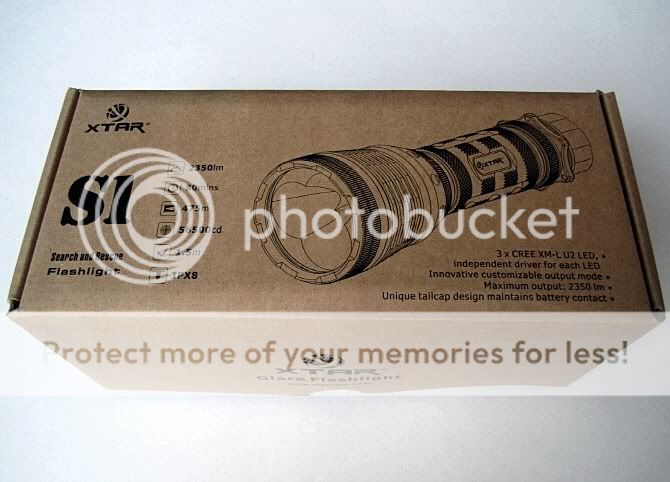
XTAR has officially released S1-final version. They revised S1-test version according to the reviews comments and suggestions. (I did a review on the test version.)
The S1 final version comes in a sturdy cardboard box, with built-in packing foam and closing flap.
.
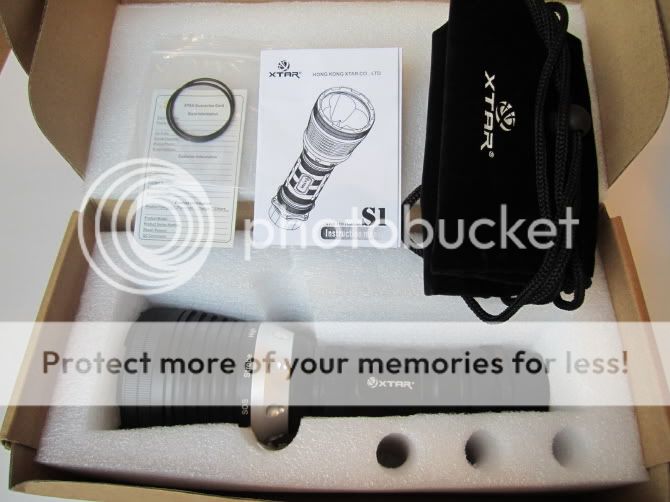
Inside is the light, spare o-ings, instruction manual, lanyard, warranty card, and nice pouch.
.
Manufacturer's specifications & features :
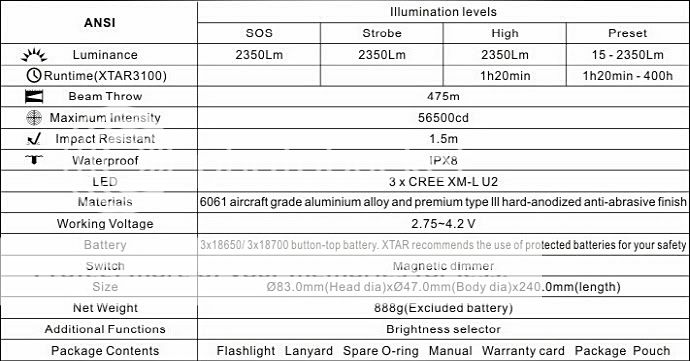
.
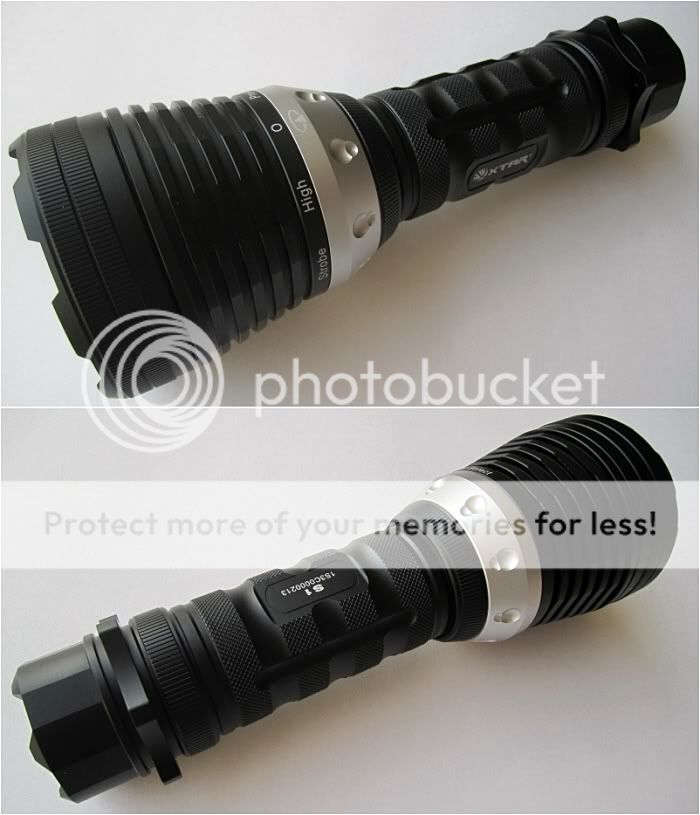
The final version is sturdy and imposing even just at a glance.
Lst's see how much the final version has changed from the test version of S1 in detail.
.
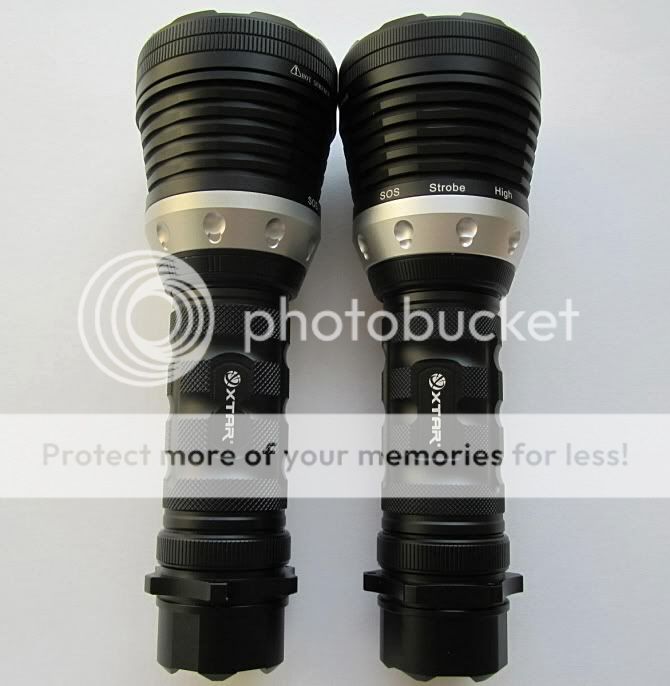
Test version is on the left in the picture and final version on the right. (will be continued in the same order as above.)
They look the same on the surface.
.
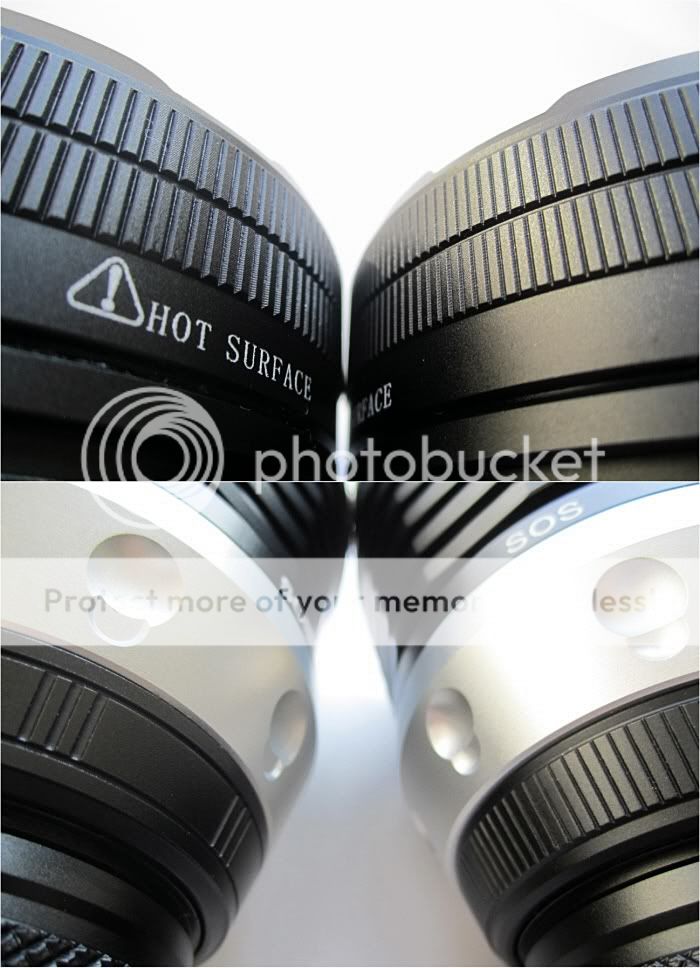
The external features that have changed on the head are fluted ridges along the bezel ring, and the lower ring which supports a silver magnetic selector ring.
One other change is the rounded groove shape on the selector ring. Thanks to its change, I can switch back and forth one-handed with ease.
.
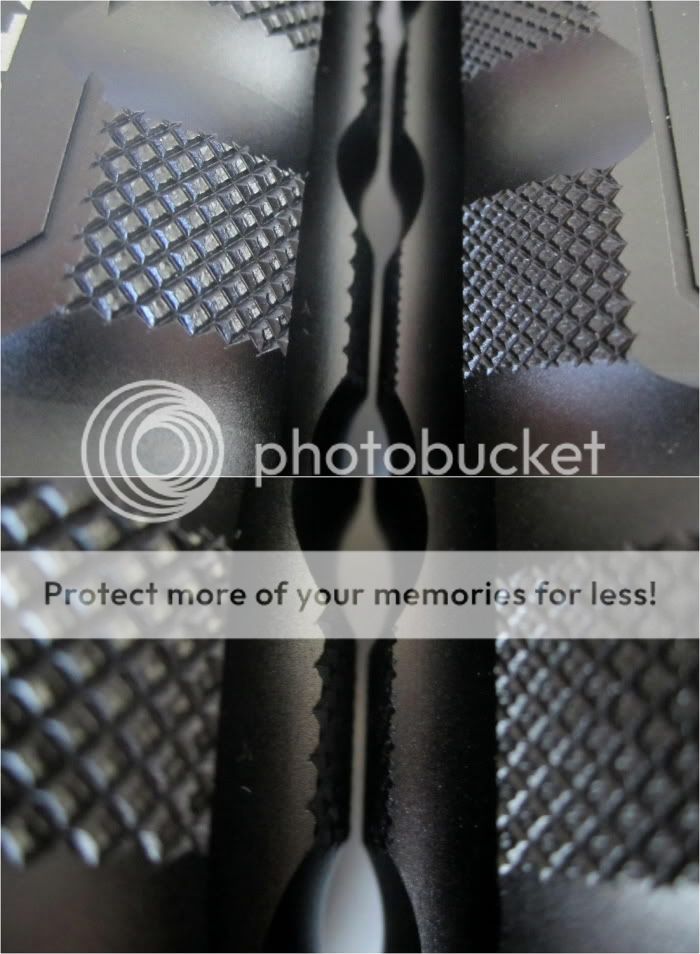
The knurling on the battery tube is less aggressive, but the overall grip is certainly reasonable.
.
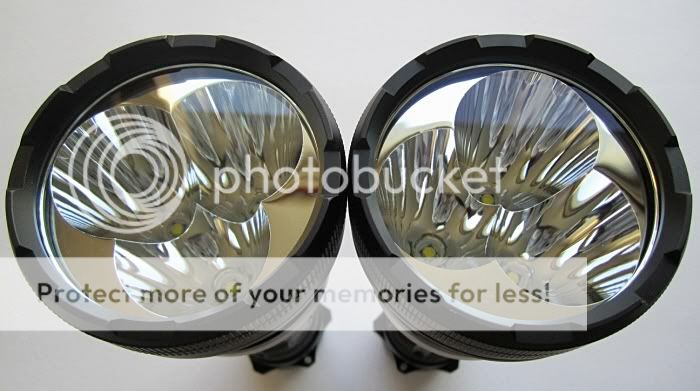
I can't open the bezel ring on the final version, it seems to be bonded with strong adhesive. The final version has a toughened AR coating lens, while test version a toughtened lens.
.
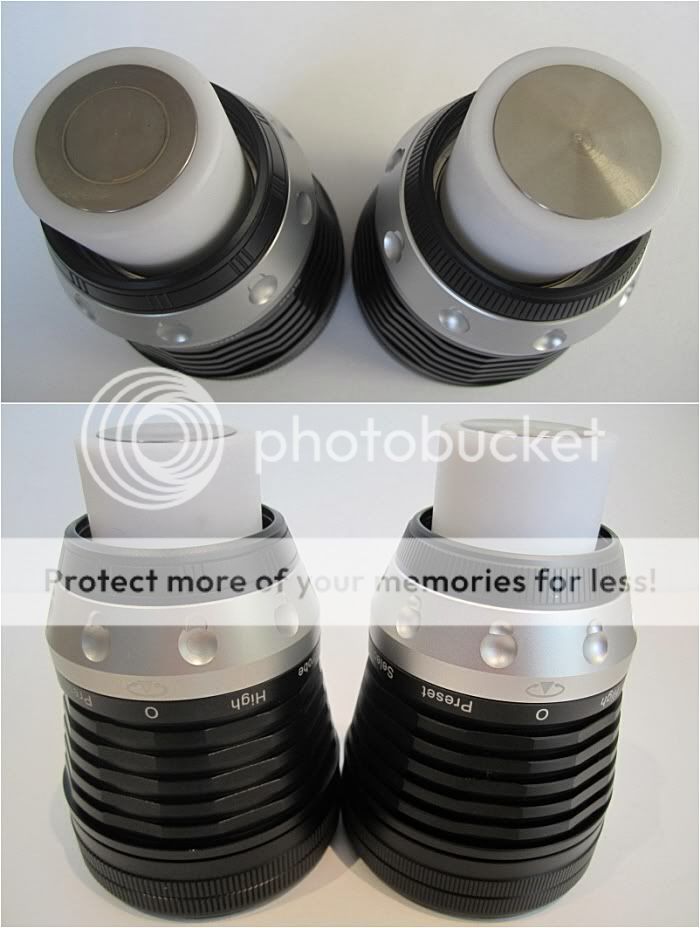
The tiny groove on the positive contact plate is removed and the positive contact block is increased in length. The final version is not different in its 6 labeled modes on the head of the light (i.e. SOS - Strobe - High - Off("O") - Preset - Select, Arranged clockwise). The test version's selector ring continues to turn past all the output modes in either direction. But XTAR prevent the ring from turning to the rigion where there is no output mode, and reduce the total traverse of the ring to 1/2 circumference of the final version.
[Update - 2012.04.23] The silver positive contact plate rotates a bit smoothly as before. [Update - 2012.04.23]
.
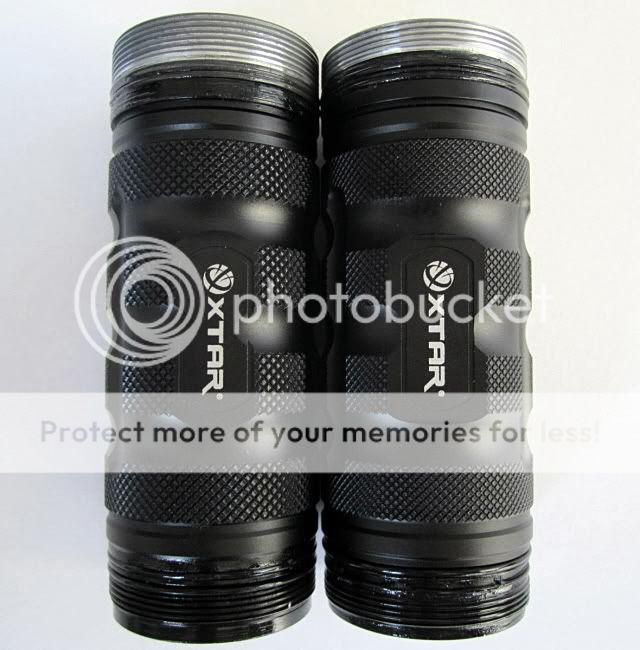
The battery tube length is reduced a little. Screw threads are anodized for tailcap lockout as the test version was.
.
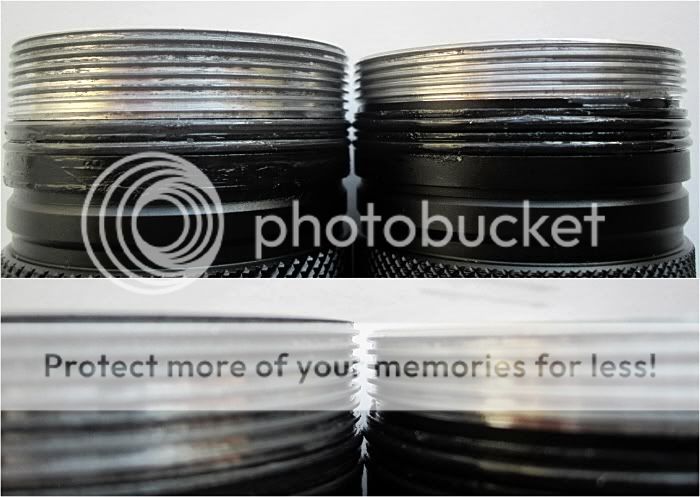
The threads toward the head are square cut, but there is a decreasing in the number of the threads from 7 to 5.
.
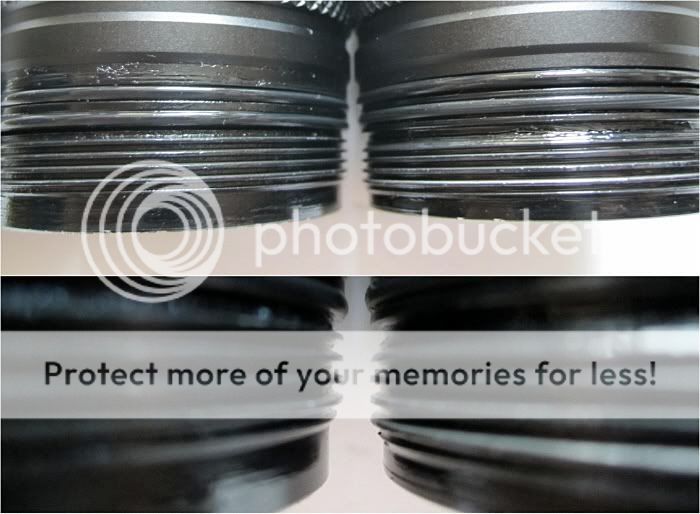
The threads toward the tailcap are anodized square cut. There is no change in the number of threads.
.
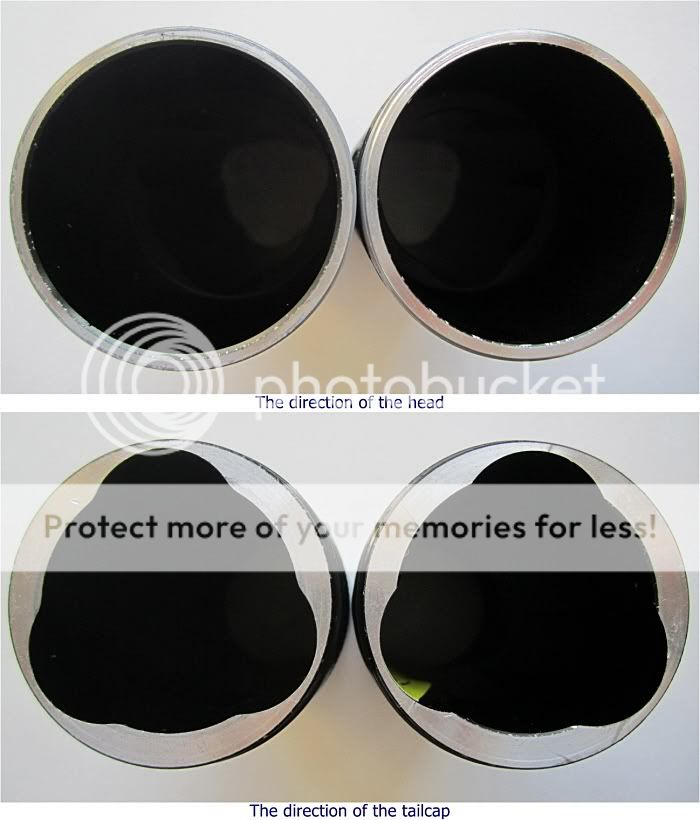
The thinnest part of the battery tube is 2 mm thick. The light is definitely one of the most solid lights I've seen.
.
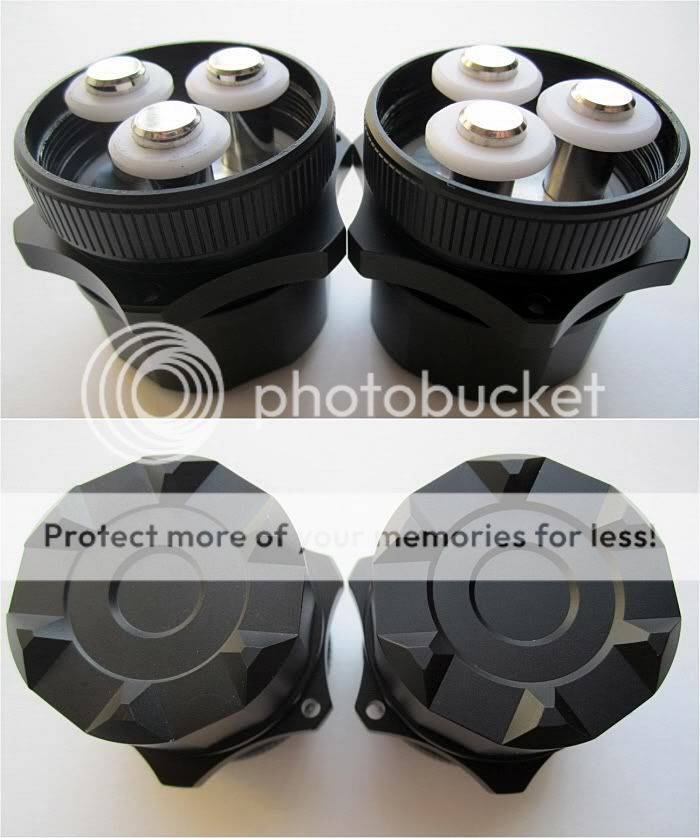
The tailcaps are identical and the light can tailstand perfectly. There are 3 small holes machined into the tailcap ring for lanyard or split-ring attachment.
[Update - 2012.04.23] The three negative contacts & the base plate on the tailcap rotate much more freely than the positive contact plate on the head as before. [Update - 2012.04.23]
.
[Update - 2012.04.23]
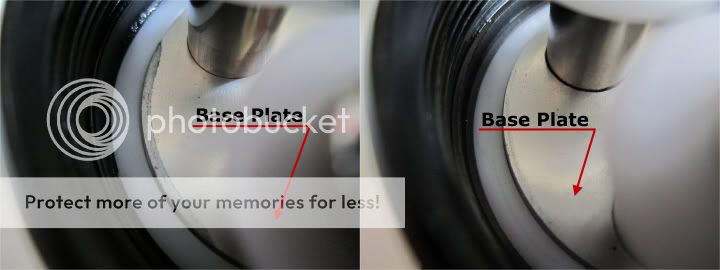
The both tailcaps are fit in each battery tube well, but are not interchangeable between the test & final version.
i.e. The tailcap of the final version fit in the body of the test version and the light just works fine. But the light doesn't work when fitting the tailcap of the test version in the body of the final version. It' is because the height of the base plate on the test version is less than the final version as shown above. I don't mean this is an issue in the final version. This is related to the use of the flat-top cells. [Update - 2012.04.23]
Overall build quality seems excellent.
.
User Interface
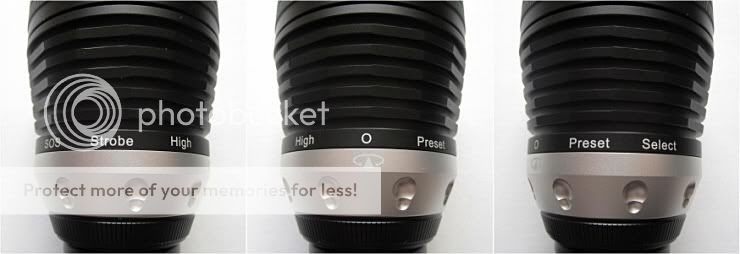
As before, final version is not different in its UI.
On/off and mode switching is controlled entirely by the silver magnetic selector ring in the head. You can select any mode by rotating the selector ring. The preset mode is user-defined brightness at a certain level. When rotating the "▲" symbol on the selector ring to "Select" position, the light output will begin to ramp up and down in a repeating loop, starting from the current preset output level. To select the output level you want, simply rotate the "▲" symbol on the selector ring quickly back to the "Preset" position. Once an output level is selected, that level is memorized (i.e. will always return to that level unless you start a new Select ramp). The range of the Select mode manufacturer claims is 15~2350 lumens.
.
Ramp
The ramp of the test version is 7 secs from min. to max. output level, totally 14 secs cycle. What this means is that the test version ramp is so quick that you can't select the output level precisely you want. The final version has much longer ramping time for selecting output level (i.e. from 15 lumens to 2350 lumens takes about 22 secs), and there is a 1.5 sec pause at 3%, 25%, 50%, 75%, 98% output level to help the precisely selecting of output level as shown below. The current revision of the ramp is very welcome and nice change according to the user's feedbacks.
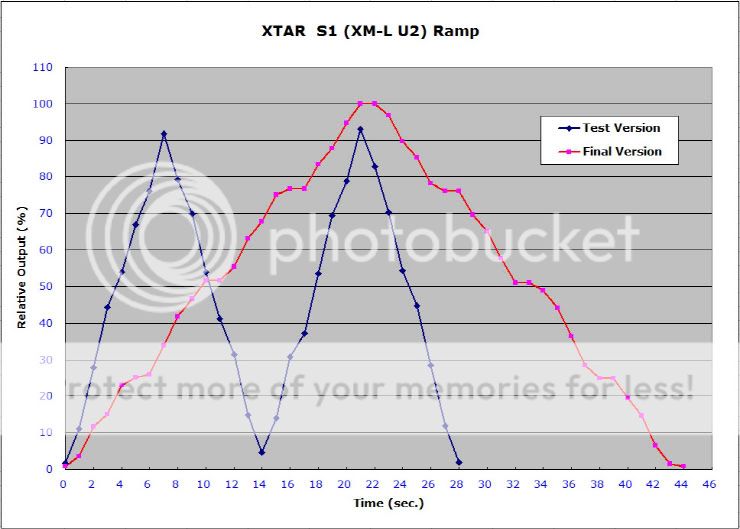
But I think the adding a 1~2 secs pause only at those output levels is not a great help me to know what the current output level is. Personally, I don't see the need for 25% and 75% pauses in the ramp. I would like to suggest that XTAR make the light flicker once at 0%, and twice at 50% output, and three times at max.(100%) output to remind users the current output level by keeping 1~2 secs pause at those output levels. This will probably reduce the ramping time to 8 secs (i.e. with 14 secs between min. and max. outputs).
.
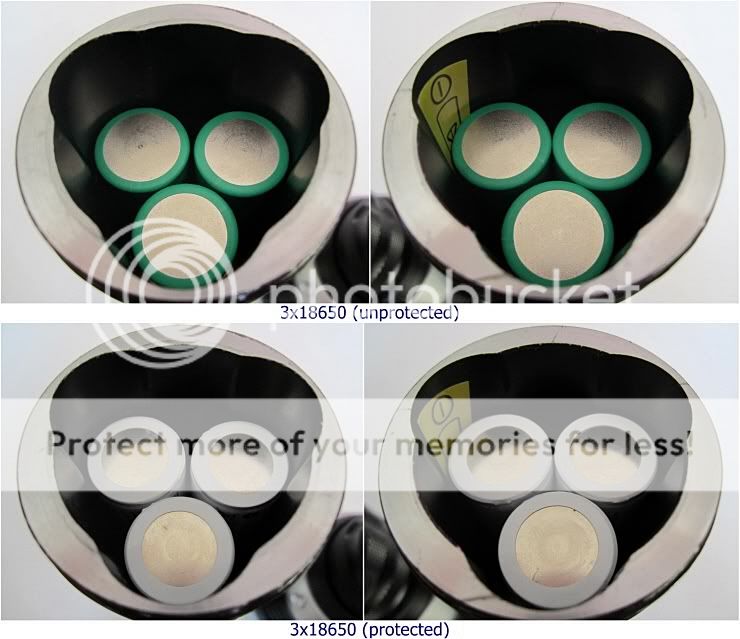
The flat-top 18650 cells do not work in the test version, but the button-top cells work fine. (If you attach a neodymium magnet(NdFeB) on the flat-top cells in the test version, no problem at all.) Now you can use the flat-top 18650 cells without using a magnet in the final version.
.
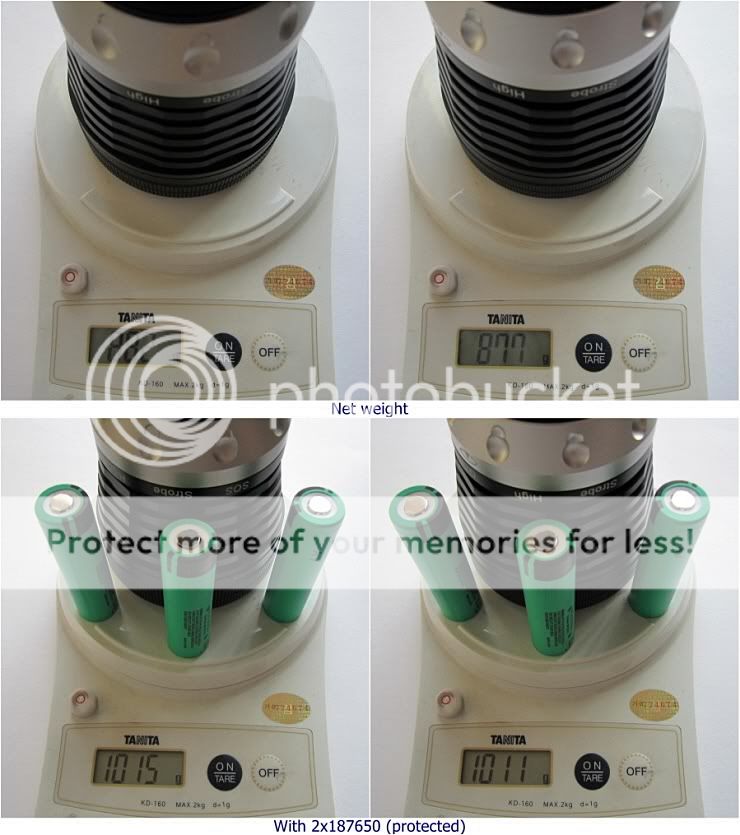
The final version is not appreciably different in its weight.
.
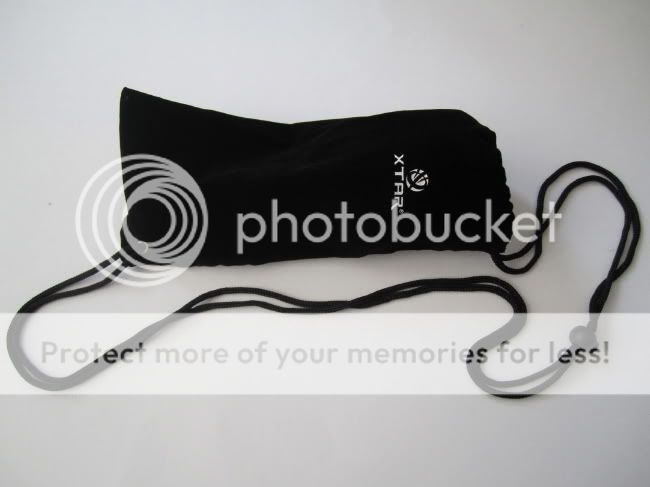
The light comes with a nice pouch instead of a holster.
.
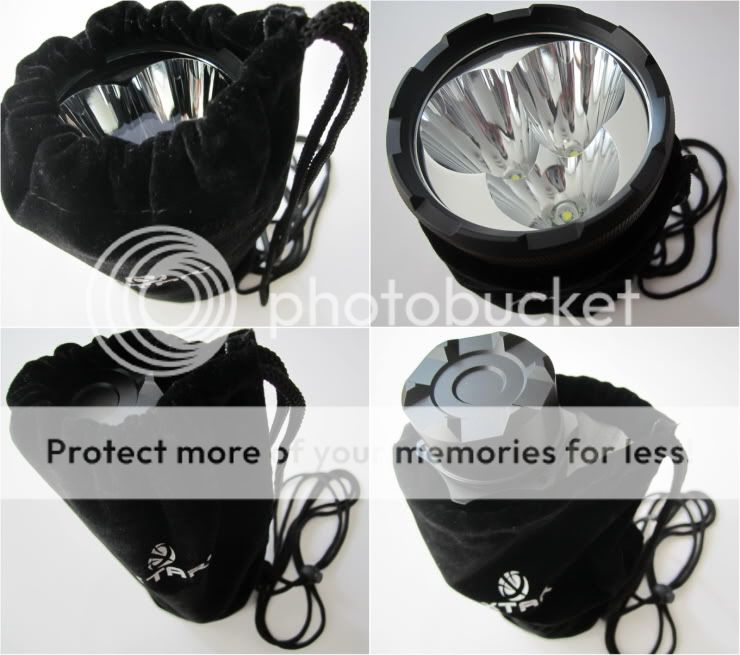
I don't think a holster is a good idea for such a big size light, but with a pouch, I can either put the light in my bag without got scratched, or can carry it on my shoulder.
.
PWM
I can see flickering at lower output level when intentionally waving the light. But I can't see it visually in practical use. There is no sign of PWM at high mode as before. I notice that there is very little buzzing sound on the preset mode amd select mode as before.
.
Runtime
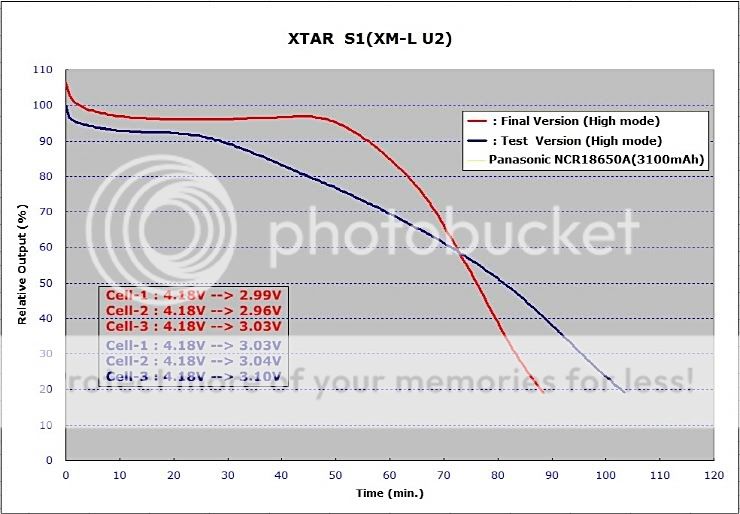
The runtime for 50% output of high level on 3xPanasonic unprotected 18650(3100mAh)'s for test & final version are appr. 82 & 75 mins respectively in my test. The test version provides good runtime, while it doesn't provide steady or flat regulation. However the final version does appear to be flatly regulated at high level, while provides less runtime than test version.
The revised final version seems to have a little more output. I stop running the lights to protect the batteries from overdischarge in 89 mins & 104 mins respectively.
The voltage of the battery at the start and end of the test is as follows :
1) Test Version
Cell-1 : 4.18V --> 2.99V
Cell-2 : 4.18V --> 2.96V
Cell-3 : 4.18V --> 3.03V
2) Final Version
Cell-1 : 4.18V --> 3.03V
Cell-2 : 4.18V --> 3.04V
Cell-3 : 4.18V --> 3.10V
.
Beamshot
1) Light ivory wall beamshot (about 60cm from the wall)
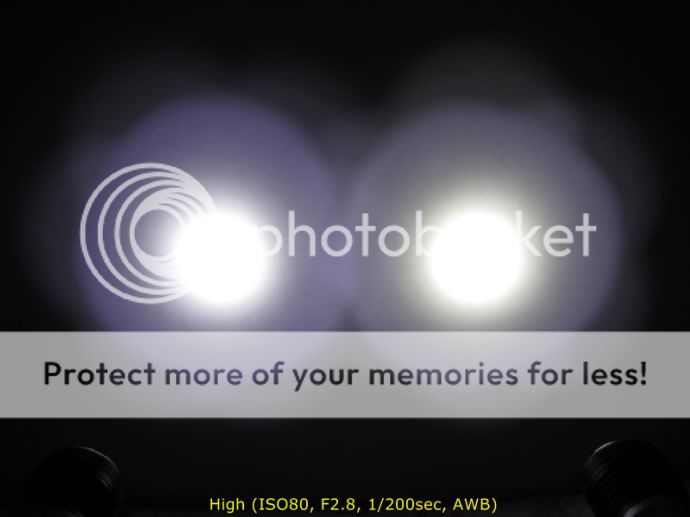
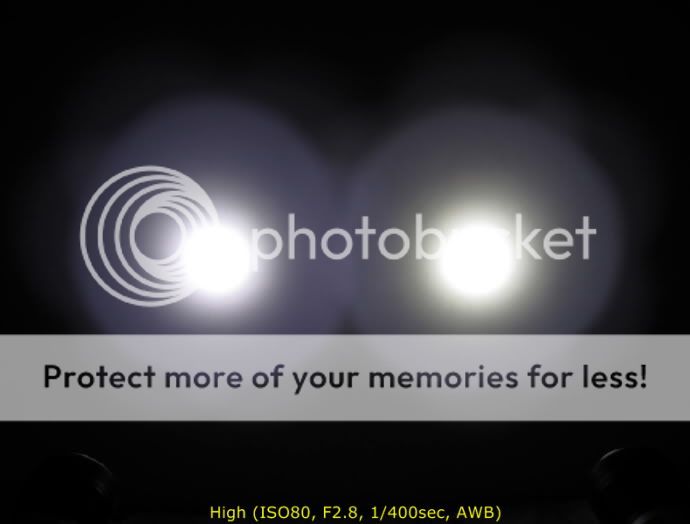
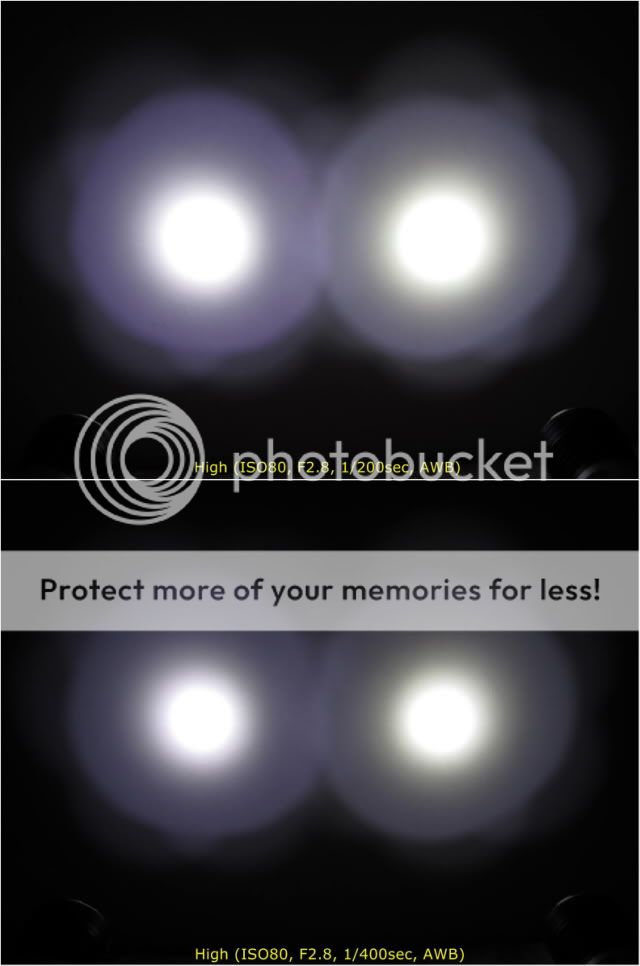
The beam profile of test & final version produces a small sized hotspot with a soft corona tapering into the spill beam. At a close range(i.e.~5m), the spill beam looks like a triangular petal-like pattern. But it is hardly noticeable or is not issue in real life. The beam tint on test version towards quite cool side of the color spectrum noticeably blue, but the beam tint on final version is close to neutral white perhaps leaning just slightly towards the cool side, but not by much.
.
[Update - 2012.04.22] Indoor beamshot is uploaded.
2) Indoor beamshot (about 7m from the target)
2-1) Test version
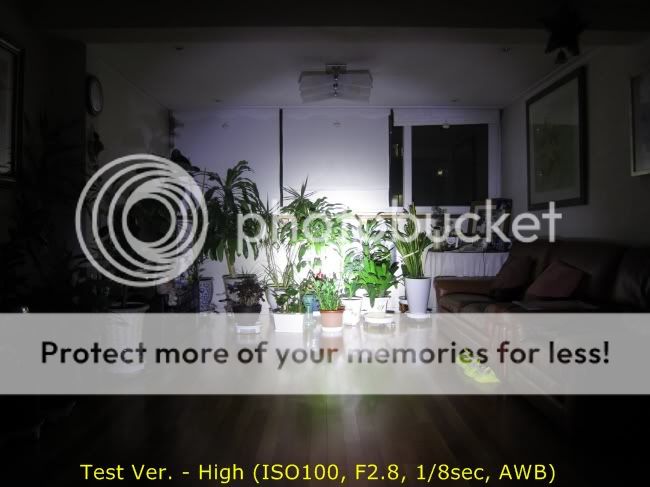
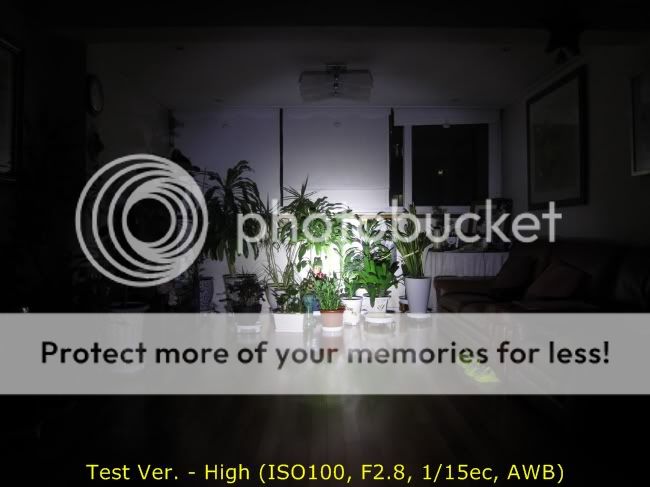
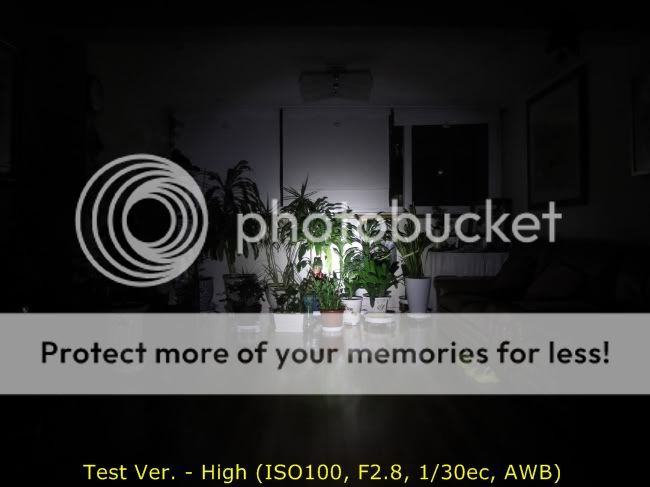
2-2) Final version
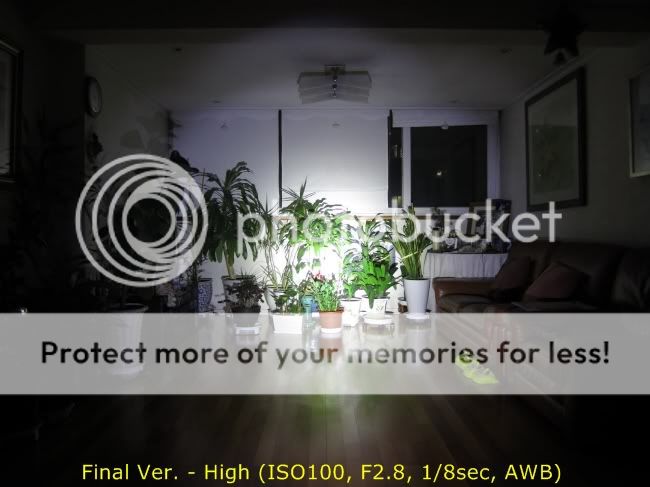
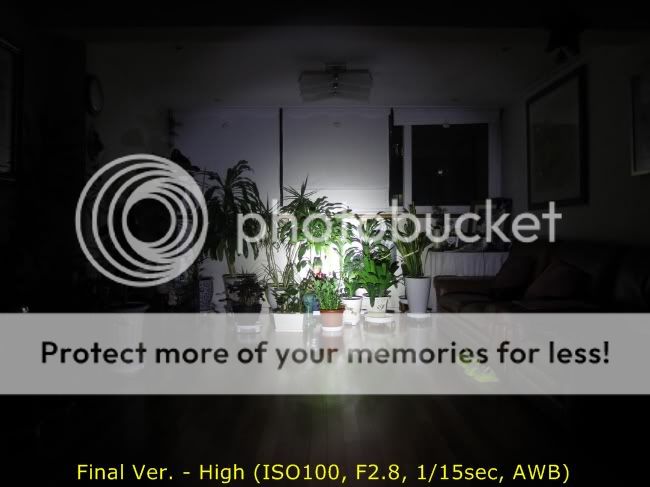
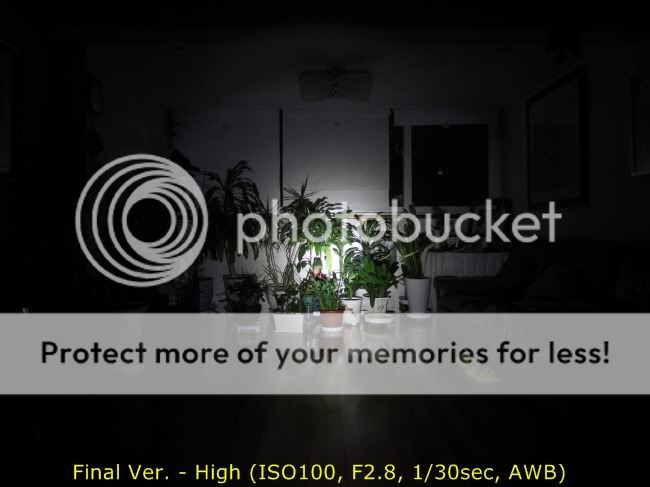
2-3) Test version(left) & Final version(right)
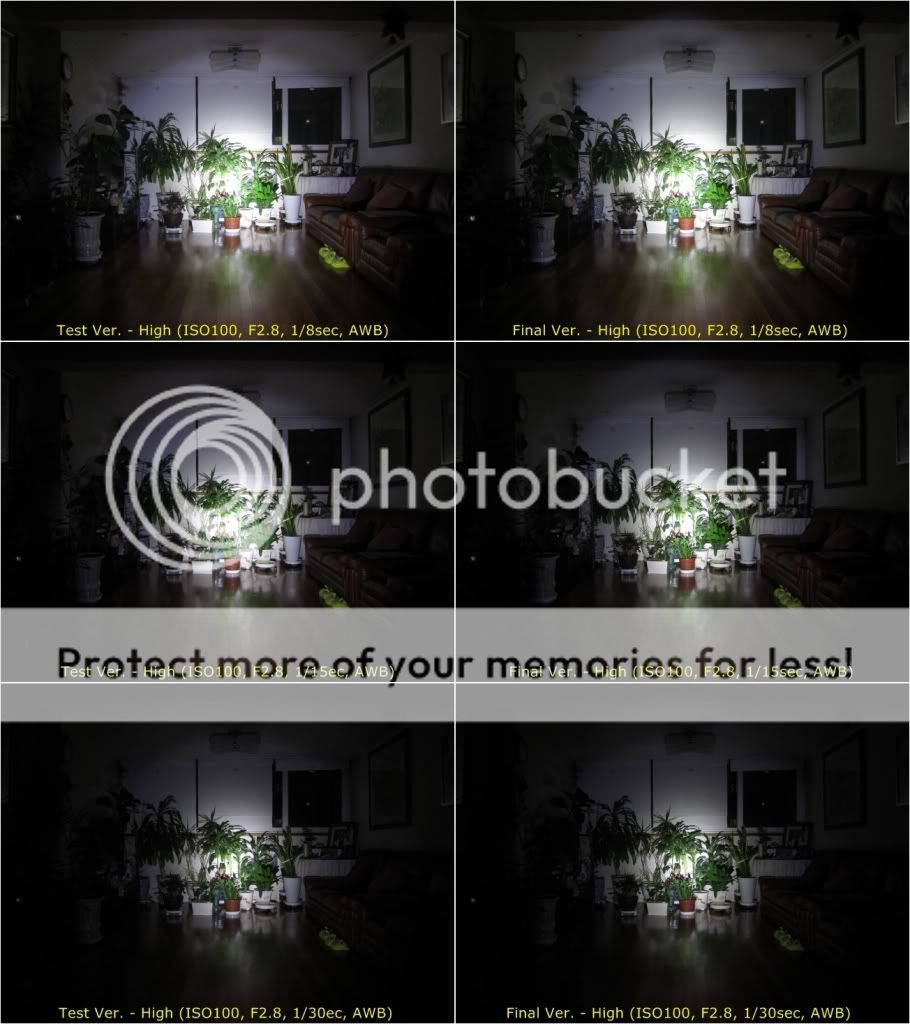
.
3) Outdoor beamshot (about 60~65m from the target)
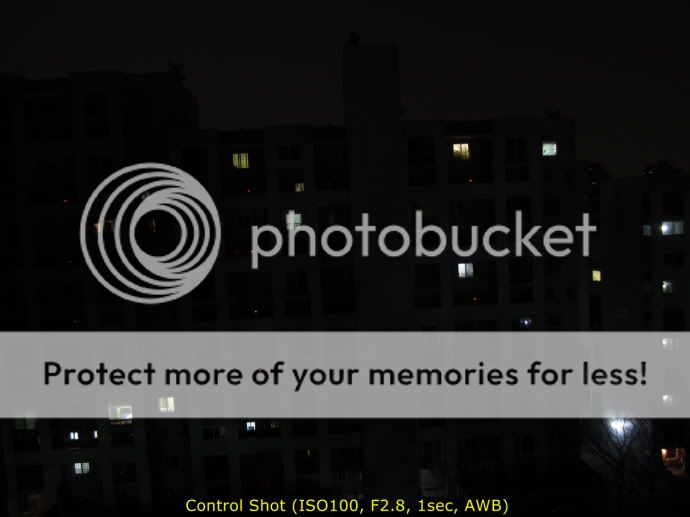
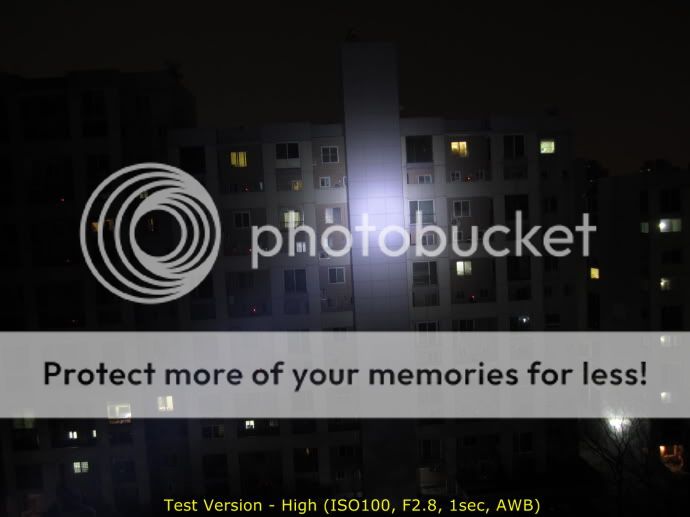
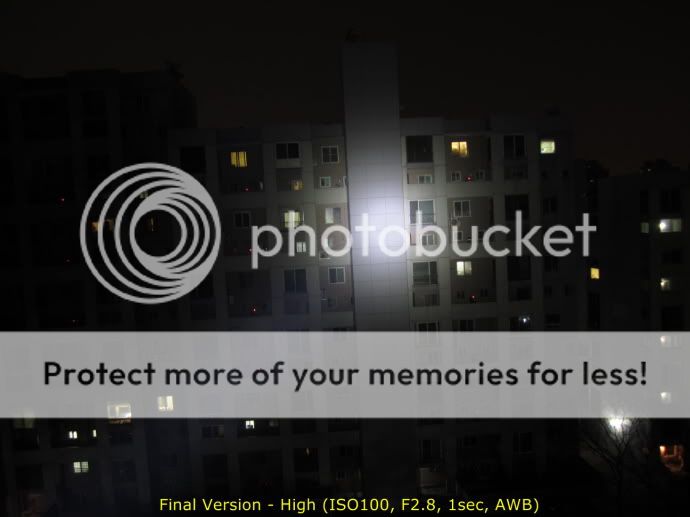
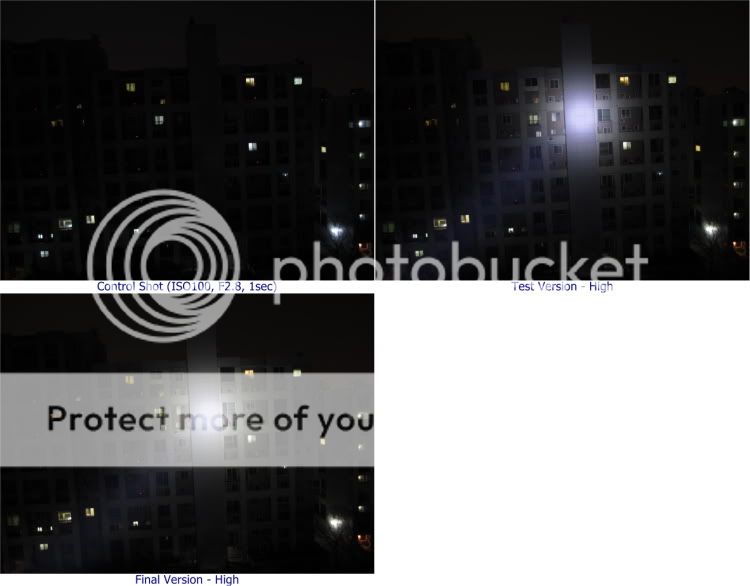
.
4) Outdoor beamshot (about 60~65m from the target)
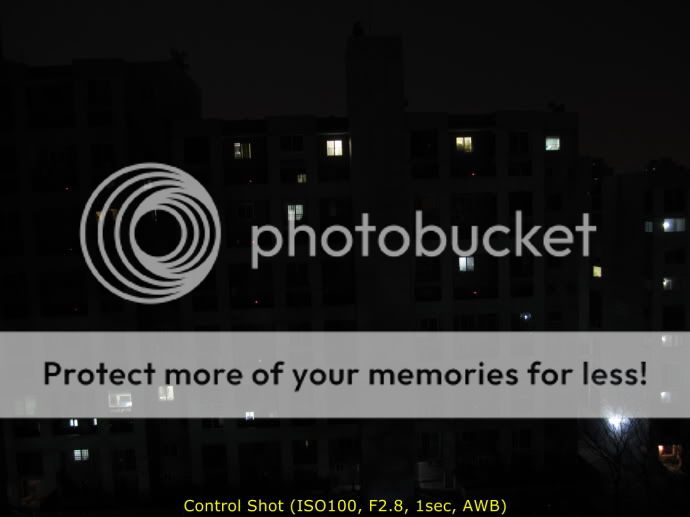
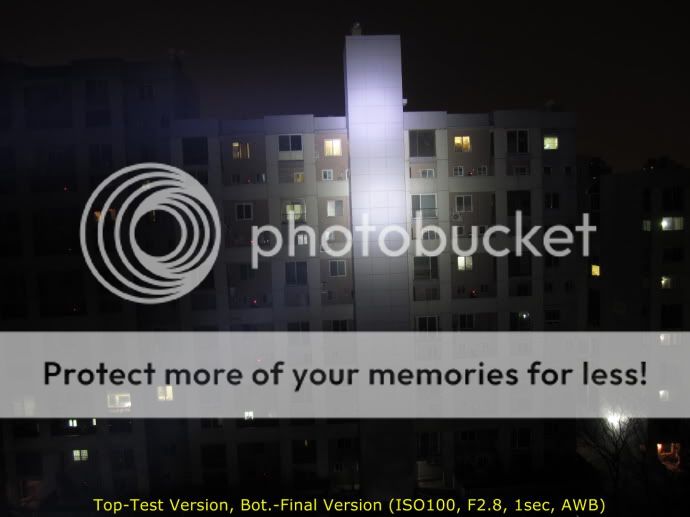
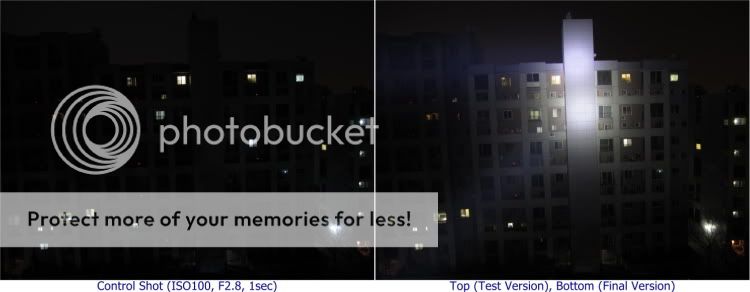
.
5) Outdoor beamshot (about 55m from the target)
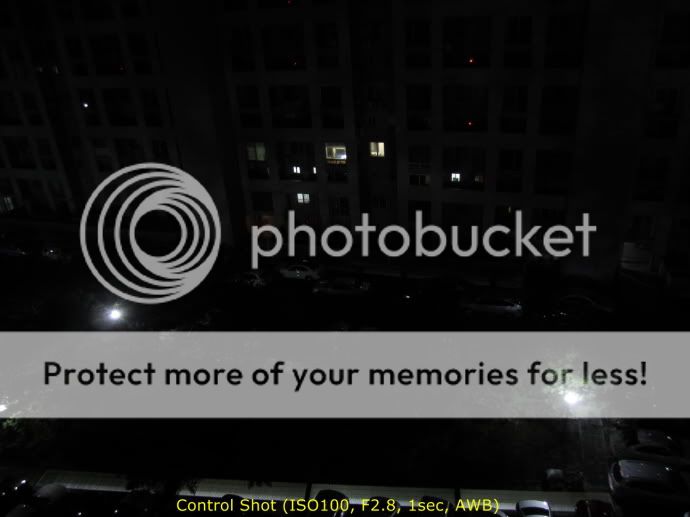
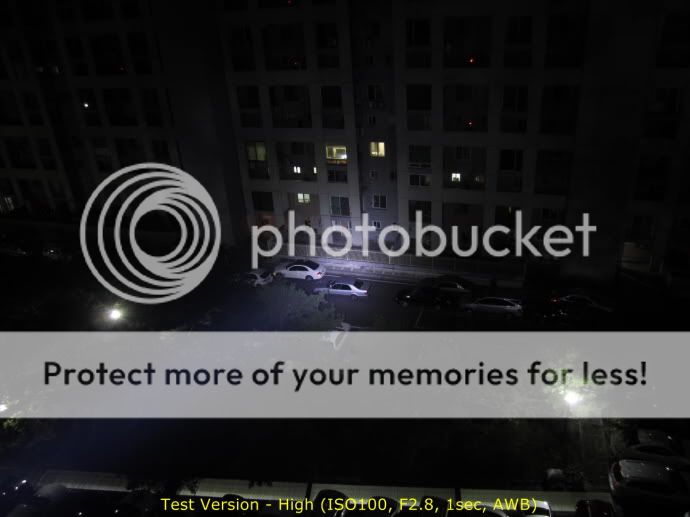
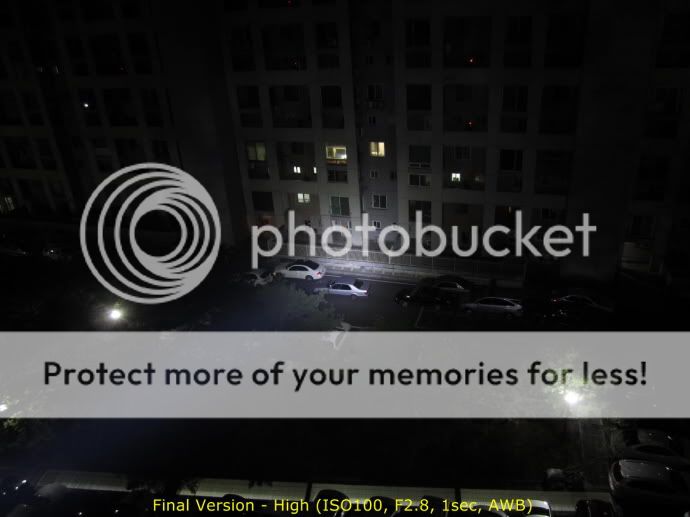
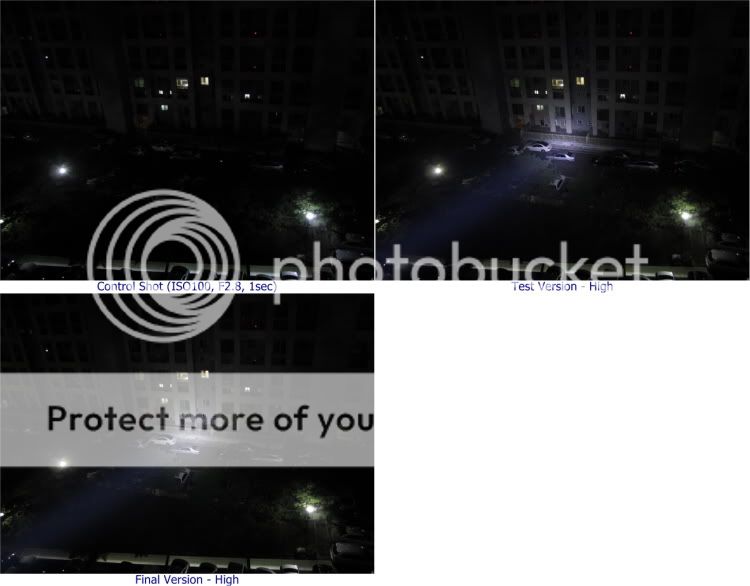
.
6) Outdoor beamshot (far more than 130m from the target)
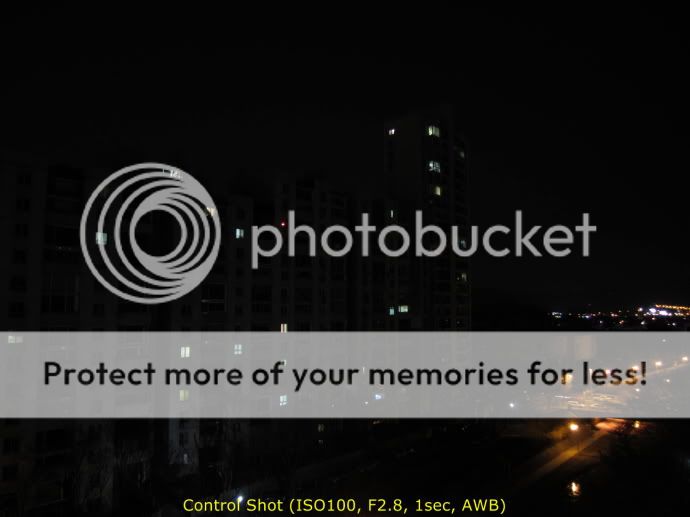
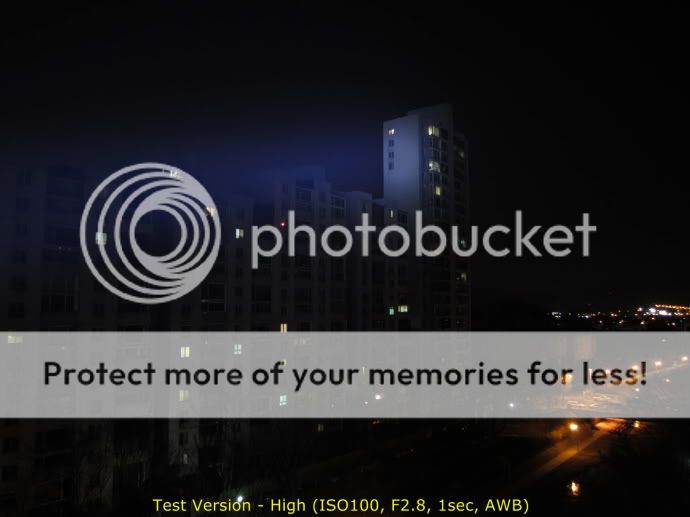
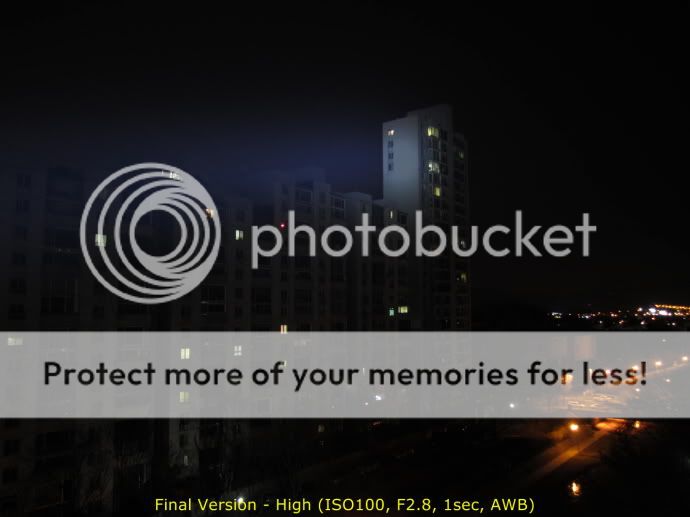
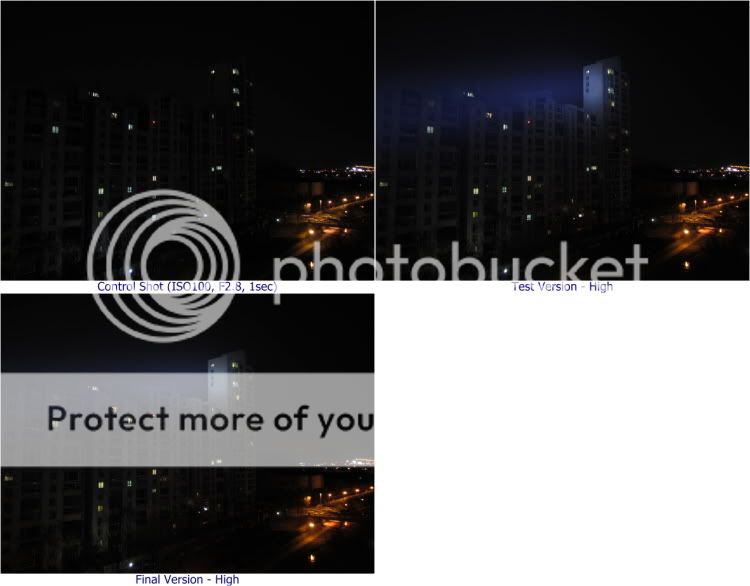
.
[Update - 2012.04.21] Peak Throw & Beam Distance
1) Test version
I measured 56,100 lux at 1m, with full charged NCR18650As, is based on 30 secs after activation which translates into an ANSI FL-1 beam distance of 473m.
2) Final version
I measured 60,600 lux at 1m, with full charged NCR18650As, is based on 30 secs after activation which translates into an ANSI FL-1 beam distance of 492m.
The final version seems to have a little more output, resulting in slightly greater throw as well. I think this is due to an improved circuit board to have better regulated output and a toughened AR coating lens.
[ Note (12.04.22) : You can find the S1-test version review here. ]
Note : This is Xtar S1 Comparison Review - Test version & Final version.

XTAR has officially released S1-final version. They revised S1-test version according to the reviews comments and suggestions. (I did a review on the test version.)
The S1 final version comes in a sturdy cardboard box, with built-in packing foam and closing flap.
.

Inside is the light, spare o-ings, instruction manual, lanyard, warranty card, and nice pouch.
.
Manufacturer's specifications & features :

.

The final version is sturdy and imposing even just at a glance.
Lst's see how much the final version has changed from the test version of S1 in detail.
.

Test version is on the left in the picture and final version on the right. (will be continued in the same order as above.)
They look the same on the surface.
.

The external features that have changed on the head are fluted ridges along the bezel ring, and the lower ring which supports a silver magnetic selector ring.
One other change is the rounded groove shape on the selector ring. Thanks to its change, I can switch back and forth one-handed with ease.
.

The knurling on the battery tube is less aggressive, but the overall grip is certainly reasonable.
.

I can't open the bezel ring on the final version, it seems to be bonded with strong adhesive. The final version has a toughened AR coating lens, while test version a toughtened lens.
.

The tiny groove on the positive contact plate is removed and the positive contact block is increased in length. The final version is not different in its 6 labeled modes on the head of the light (i.e. SOS - Strobe - High - Off("O") - Preset - Select, Arranged clockwise). The test version's selector ring continues to turn past all the output modes in either direction. But XTAR prevent the ring from turning to the rigion where there is no output mode, and reduce the total traverse of the ring to 1/2 circumference of the final version.
[Update - 2012.04.23] The silver positive contact plate rotates a bit smoothly as before. [Update - 2012.04.23]
.

The battery tube length is reduced a little. Screw threads are anodized for tailcap lockout as the test version was.
.

The threads toward the head are square cut, but there is a decreasing in the number of the threads from 7 to 5.
.

The threads toward the tailcap are anodized square cut. There is no change in the number of threads.
.

The thinnest part of the battery tube is 2 mm thick. The light is definitely one of the most solid lights I've seen.
.

The tailcaps are identical and the light can tailstand perfectly. There are 3 small holes machined into the tailcap ring for lanyard or split-ring attachment.
[Update - 2012.04.23] The three negative contacts & the base plate on the tailcap rotate much more freely than the positive contact plate on the head as before. [Update - 2012.04.23]
.
[Update - 2012.04.23]

The both tailcaps are fit in each battery tube well, but are not interchangeable between the test & final version.
i.e. The tailcap of the final version fit in the body of the test version and the light just works fine. But the light doesn't work when fitting the tailcap of the test version in the body of the final version. It' is because the height of the base plate on the test version is less than the final version as shown above. I don't mean this is an issue in the final version. This is related to the use of the flat-top cells. [Update - 2012.04.23]
Overall build quality seems excellent.
.
User Interface

As before, final version is not different in its UI.
On/off and mode switching is controlled entirely by the silver magnetic selector ring in the head. You can select any mode by rotating the selector ring. The preset mode is user-defined brightness at a certain level. When rotating the "▲" symbol on the selector ring to "Select" position, the light output will begin to ramp up and down in a repeating loop, starting from the current preset output level. To select the output level you want, simply rotate the "▲" symbol on the selector ring quickly back to the "Preset" position. Once an output level is selected, that level is memorized (i.e. will always return to that level unless you start a new Select ramp). The range of the Select mode manufacturer claims is 15~2350 lumens.
.
Ramp
The ramp of the test version is 7 secs from min. to max. output level, totally 14 secs cycle. What this means is that the test version ramp is so quick that you can't select the output level precisely you want. The final version has much longer ramping time for selecting output level (i.e. from 15 lumens to 2350 lumens takes about 22 secs), and there is a 1.5 sec pause at 3%, 25%, 50%, 75%, 98% output level to help the precisely selecting of output level as shown below. The current revision of the ramp is very welcome and nice change according to the user's feedbacks.

But I think the adding a 1~2 secs pause only at those output levels is not a great help me to know what the current output level is. Personally, I don't see the need for 25% and 75% pauses in the ramp. I would like to suggest that XTAR make the light flicker once at 0%, and twice at 50% output, and three times at max.(100%) output to remind users the current output level by keeping 1~2 secs pause at those output levels. This will probably reduce the ramping time to 8 secs (i.e. with 14 secs between min. and max. outputs).
.

The flat-top 18650 cells do not work in the test version, but the button-top cells work fine. (If you attach a neodymium magnet(NdFeB) on the flat-top cells in the test version, no problem at all.) Now you can use the flat-top 18650 cells without using a magnet in the final version.
.

The final version is not appreciably different in its weight.
.

The light comes with a nice pouch instead of a holster.
.

I don't think a holster is a good idea for such a big size light, but with a pouch, I can either put the light in my bag without got scratched, or can carry it on my shoulder.
.
PWM
I can see flickering at lower output level when intentionally waving the light. But I can't see it visually in practical use. There is no sign of PWM at high mode as before. I notice that there is very little buzzing sound on the preset mode amd select mode as before.
.
Runtime

The runtime for 50% output of high level on 3xPanasonic unprotected 18650(3100mAh)'s for test & final version are appr. 82 & 75 mins respectively in my test. The test version provides good runtime, while it doesn't provide steady or flat regulation. However the final version does appear to be flatly regulated at high level, while provides less runtime than test version.
The revised final version seems to have a little more output. I stop running the lights to protect the batteries from overdischarge in 89 mins & 104 mins respectively.
The voltage of the battery at the start and end of the test is as follows :
1) Test Version
Cell-1 : 4.18V --> 2.99V
Cell-2 : 4.18V --> 2.96V
Cell-3 : 4.18V --> 3.03V
2) Final Version
Cell-1 : 4.18V --> 3.03V
Cell-2 : 4.18V --> 3.04V
Cell-3 : 4.18V --> 3.10V
.
Beamshot
1) Light ivory wall beamshot (about 60cm from the wall)



The beam profile of test & final version produces a small sized hotspot with a soft corona tapering into the spill beam. At a close range(i.e.~5m), the spill beam looks like a triangular petal-like pattern. But it is hardly noticeable or is not issue in real life. The beam tint on test version towards quite cool side of the color spectrum noticeably blue, but the beam tint on final version is close to neutral white perhaps leaning just slightly towards the cool side, but not by much.
.
[Update - 2012.04.22] Indoor beamshot is uploaded.
2) Indoor beamshot (about 7m from the target)
2-1) Test version



2-2) Final version



2-3) Test version(left) & Final version(right)

.
3) Outdoor beamshot (about 60~65m from the target)




.
4) Outdoor beamshot (about 60~65m from the target)



.
5) Outdoor beamshot (about 55m from the target)




.
6) Outdoor beamshot (far more than 130m from the target)




.
[Update - 2012.04.21] Peak Throw & Beam Distance
1) Test version
I measured 56,100 lux at 1m, with full charged NCR18650As, is based on 30 secs after activation which translates into an ANSI FL-1 beam distance of 473m.
2) Final version
I measured 60,600 lux at 1m, with full charged NCR18650As, is based on 30 secs after activation which translates into an ANSI FL-1 beam distance of 492m.
The final version seems to have a little more output, resulting in slightly greater throw as well. I think this is due to an improved circuit board to have better regulated output and a toughened AR coating lens.
[ Note (12.04.22) : You can find the S1-test version review here. ]
Last edited:
madecov
Flashlight Enthusiast
Re: XTAR S1 Comparison Review - Test Version & Final Version
Nice review
Nice review
- Joined
- Mar 7, 2007
- Messages
- 644
Re: XTAR S1 Comparison Review - Test Version & Final Version
Nice review and excellent comparison between test and final version.
Nice review and excellent comparison between test and final version.
candle lamp
Flashlight Enthusiast
Re: XTAR S1 Comparison Review - Test Version & Final Version
Thanks for your good words. Gentlemen!
Yes, it does cast a pretty intense beam. :duck:
Nice review
Nice review and excellent comparison between test and final version.
Great review. That torch casts a pretty intense beam.
Thanks for your good words. Gentlemen!
Yes, it does cast a pretty intense beam. :duck:
Re: XTAR S1 Comparison Review - Test Version & Final Version
A lot of the pics in post #22 are red X's... but I ordered an XTAR S1 anyway!
EDIT- I got pics to load..
One observation:
''The tailcaps are identical''
I noticed new tailcap has a deeper step-down into first machined circle, and the middle machined circle is larger in diameter. I also think the little triangular shaped ''feet'' that would be touching ground if tail-standing are a tiny bit larger.
I Love all those macro shots- you can really see all the little machining differences.
A lot of the pics in post #22 are red X's... but I ordered an XTAR S1 anyway!
EDIT- I got pics to load..
One observation:
''The tailcaps are identical''
I noticed new tailcap has a deeper step-down into first machined circle, and the middle machined circle is larger in diameter. I also think the little triangular shaped ''feet'' that would be touching ground if tail-standing are a tiny bit larger.
I Love all those macro shots- you can really see all the little machining differences.
Last edited:
candle lamp
Flashlight Enthusiast
Re: XTAR S1 Comparison Review - Test Version & Final Version
Thanks. BWX!
You're right and very good at finding the difference between the tailcaps.
I've also updated some notes dated on 12.04.23.
Thanks. BWX!
You're right and very good at finding the difference between the tailcaps.
I've also updated some notes dated on 12.04.23.
A lot of the pics in post #22 are red X's... but I ordered an XTAR S1 anyway!
EDIT- I got pics to load..
One observation:
''The tailcaps are identical''
I noticed new tailcap has a deeper step-down into first machined circle, and the middle machined circle is larger in diameter. I also think the little triangular shaped ''feet'' that would be touching ground if tail-standing are a tiny bit larger.
I Love all those macro shots- you can really see all the little machining differences.
At least I have this thread to check out pics while I wait for mine to come in the mail, LOL.
Hey, does the silver magnetic adjustment ring look to be narrower on the final version? I don't mean up and down, but the entire width of the light where the ring is. Might just be photo angles.
The production version is definitely a completely new light. Very similar, but it looks like the body has completely new machining.
Hey, does the silver magnetic adjustment ring look to be narrower on the final version? I don't mean up and down, but the entire width of the light where the ring is. Might just be photo angles.
The production version is definitely a completely new light. Very similar, but it looks like the body has completely new machining.
candle lamp
Flashlight Enthusiast
At least I have this thread to check out pics while I wait for mine to come in the mail, LOL.
Hey, does the silver magnetic adjustment ring look to be narrower on the final version? I don't mean up and down, but the entire width of the light where the ring is. Might just be photo angles.
The production version is definitely a completely new light. Very similar, but it looks like the body has completely new machining.
That's a good idea.
I've measured the circumference of the silver magnetic ring on the two lights and both is 22.2cm round. So the diameter is around 7.07cm.
I'm suprised they changed an engine, window, headlamp color, body frame, and accessaries.
 What else?
What else?357mag1
Enlightened
Thanks for the review.
Great information. Between your and selfbuilt's reviews convinced me to buy the production version of this light.
Great information. Between your and selfbuilt's reviews convinced me to buy the production version of this light.
candle lamp
Flashlight Enthusiast
Thanks for the review.
Great information. Between your and selfbuilt's reviews convinced me to buy the production version of this light.
Thank you too. 357mag1
May I ask you a question? What's your reason for making a purchase of it?
In my case, I love the upgraded circuit, the use of the unprotected (flat-top) 18650 cells, and nice improvement according to the feedbacks.
Well here's why I ordered the Xtar S1- because my brightest lights are my TK45, Spark SL6 800CW, and O-Light i6 Paladin... all in the same 'class' of performance. Great for their size, etc., but now that I am using 18650 batteries, it's time for more.
I've been wanting to upgrade to a multiple XML, multiple 18650 'throw-ish' light, not necessarily a dedicated thrower like an SR90, but more of a thrower than my TK45 or SL6. Size isn't an issue, I just want something that kicks ***.
As soon as I saw the production version S1 reviews, and saw how it had better regulation, better tint, more output, tweaked machining, and everything else, I was sold.
The top quality machining and overall quality was important. The beam ''throwy-ness'' was a perfect compromise I thought. The overall output is great. Now came price- I wasn't sure how much I wanted to spend on my new beast of a light, but I couldn't spend too much. After I read all the reviews and decided I was interested, I shopped around a little for the best price. Once I saw how much I could get it for, I didn't hesitate. I though it was a hell of a deal.
The test pre-production version was an even better deal.. about $30 cheaper, but with all the improvements, the final production unit was well worth the asking price. $200 for a light like this? Amazing deal.. I thought I'd be spending quite a bit more for a quality flashlight with this level of performance actually. I just can't believe they aren't all sold out already..
I've been wanting to upgrade to a multiple XML, multiple 18650 'throw-ish' light, not necessarily a dedicated thrower like an SR90, but more of a thrower than my TK45 or SL6. Size isn't an issue, I just want something that kicks ***.
As soon as I saw the production version S1 reviews, and saw how it had better regulation, better tint, more output, tweaked machining, and everything else, I was sold.
The top quality machining and overall quality was important. The beam ''throwy-ness'' was a perfect compromise I thought. The overall output is great. Now came price- I wasn't sure how much I wanted to spend on my new beast of a light, but I couldn't spend too much. After I read all the reviews and decided I was interested, I shopped around a little for the best price. Once I saw how much I could get it for, I didn't hesitate. I though it was a hell of a deal.
The test pre-production version was an even better deal.. about $30 cheaper, but with all the improvements, the final production unit was well worth the asking price. $200 for a light like this? Amazing deal.. I thought I'd be spending quite a bit more for a quality flashlight with this level of performance actually. I just can't believe they aren't all sold out already..
357mag1
Enlightened
Thank you too. 357mag1
May I ask you a question? What's your reason for making a purchase of it?
In my case, I love the upgraded circuit, the use of the unprotected (flat-top) 18650 cells, and nice improvement according to the feedbacks.
Well my main reason is addiction!!! I really don't need another light.
I was interested in the light after seeing your review of the pre-production version but wouldn't buy it because of poor regulation and incompatibility with flat-top cells. I was enamoured with the smaller format powerful light with robust build.
Once you and selfbuilt reported the regulation was fixed and flat-tops work I put one on order.
You particularly brought out the flat-top compatibility which was very important to me.
Thanks again for a comprehensive review.
candle lamp
Flashlight Enthusiast
Well here's why I ordered the Xtar S1- because my brightest lights are my TK45, Spark SL6 800CW, and O-Light i6 Paladin... all in the same 'class' of performance.
They are really good flashlights as well.
The test pre-production version was an even better deal.. about $30 cheaper, but with all the improvements, the final production unit was well worth the asking price. $200 for a light like this? Amazing deal..
I agree with you.
Well my main reason is addiction!!! I really don't need another light.
It's more applicable to me. Now I have two. :laughing:
You particularly brought out the flat-top compatibility which was very important to me.
Thanks again for a comprehensive review.
It's my pleasure.
Thank you for the detailed review. You certainly convinced me to buy a production S1.
You're welcome.
I hope all of you will be pleased with it and use it very usefully.
peteybaby
Newly Enlightened
About the flat-top cells issue: if the positive contact is still a flat metal plate, I don't understand why the production version works while the pre-production version doesn't work.
I don't have many flat-top cells, so please excuse my speculation: what happens if you use three flat-top cells whose positive contact is flush with the outside of the plastic wrapper, so that when the cells are placed into the S1, the positive contacts on the cells may just barely touch the positive contact plate in the light, but because of manufacturing imperfections, e.g. a bump on the plastic wrapper, one of the three cells actually doesn't make electrical contact? Then you'd have the light being driven only by two cells, possibly intermittently as the light is jostled.
Also, let's say the above does happen, and one day you're out for a walk and the light is on High for 20 mins on two cells, but you jostle the light and now all three cells make contact. The "fresh" cell would dump a lot of current into the two "used" cells until they equalized. Is that unhealthy for the batteries?
I don't have many flat-top cells, so please excuse my speculation: what happens if you use three flat-top cells whose positive contact is flush with the outside of the plastic wrapper, so that when the cells are placed into the S1, the positive contacts on the cells may just barely touch the positive contact plate in the light, but because of manufacturing imperfections, e.g. a bump on the plastic wrapper, one of the three cells actually doesn't make electrical contact? Then you'd have the light being driven only by two cells, possibly intermittently as the light is jostled.
Also, let's say the above does happen, and one day you're out for a walk and the light is on High for 20 mins on two cells, but you jostle the light and now all three cells make contact. The "fresh" cell would dump a lot of current into the two "used" cells until they equalized. Is that unhealthy for the batteries?
About the flat-top cells issue: if the positive contact is still a flat metal plate, I don't understand why the production version works while the pre-production version doesn't work.
I don't have many flat-top cells, so please excuse my speculation: what happens if you use three flat-top cells whose positive contact is flush with the outside of the plastic wrapper, so that when the cells are placed into the S1, the positive contacts on the cells may just barely touch the positive contact plate in the light, but because of manufacturing imperfections, e.g. a bump on the plastic wrapper, one of the three cells actually doesn't make electrical contact? Then you'd have the light being driven only by two cells, possibly intermittently as the light is jostled.
Also, let's say the above does happen, and one day you're out for a walk and the light is on High for 20 mins on two cells, but you jostle the light and now all three cells make contact. The "fresh" cell would dump a lot of current into the two "used" cells until they equalized. Is that unhealthy for the batteries?
For you too, that current = heat, and, can lead to an explosion or fire...if the protection circuits don't trip when they need to, etc....and the cell can be toast either way.
When using lights that take more than one cell, you want the cells to be matched as closely as possible, the same state of charge, and, the same internal resistance. Differences are what cause all the problems in this scenario.
Last edited:
candle lamp
Flashlight Enthusiast
About the flat-top cells issue: if the positive contact is still a flat metal plate, I don't understand why the production version works while the pre-production version doesn't work.
Hi peteybaby,
It's bacause the production version has a shorter distance between the positve contact plate and the negative contact disc than the pre-production version. ( i.e. The positive contact plate block of the final version is a bit increased in length while the battery tube length of the final version is a bit reduced.)
I don't have many flat-top cells, so please excuse my speculation: what happens if you use three flat-top cells whose positive contact is flush with the outside of the plastic wrapper, so that when the cells are placed into the S1, the positive contacts on the cells may just barely touch the positive contact plate in the light, but because of manufacturing imperfections, e.g. a bump on the plastic wrapper, one of the three cells actually doesn't make electrical contact? Then you'd have the light being driven only by two cells, possibly intermittently as the light is jostled.
Also, let's say the above does happen, and one day you're out for a walk and the light is on High for 20 mins on two cells, but you jostle the light and now all three cells make contact. The "fresh" cell would dump a lot of current into the two "used" cells until they equalized. Is that unhealthy for the batteries?
In such cases(i.e. the positive contact is flush with the plastic wrapper or a bump on the wrapper), all cells may not make electrical contact as you mention. So one or two cells should be overloaded.
I have some flat-top unprotected 18650 cells as shown in the picture and LG 3000mAh among them has almost a pure flat-top positive contact. But it's not flush with the platic wrapper or slightly higher than the plastic wrapper. I've tested with these cells for around 20 mins and gotton the almost same voltages of three cells. If someone is concerned about this matter, I would suggest using a spacer or small magnet on the positive contact.
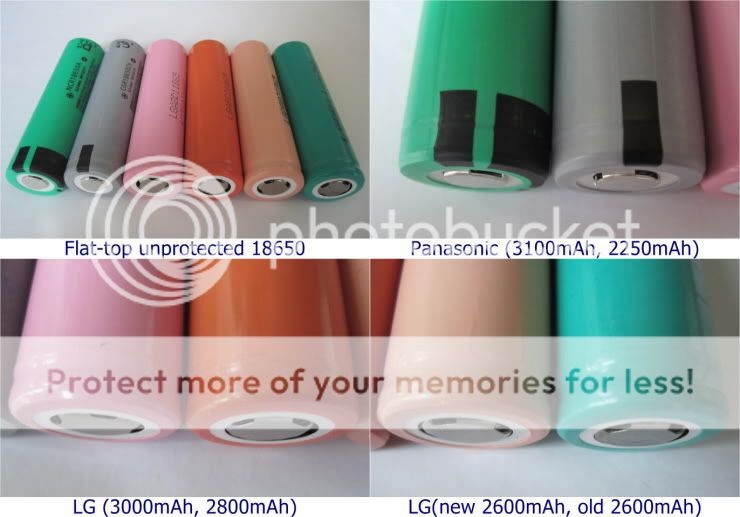
Also I'd recommend they use the batteries of same type, same brand, same charging level, same capacity, and don't mix batteries of old & new.
XTAR recommends the use of the protected batteries for safety in the manual.
Similar threads
Latest posts
-
-
-
-
-
-
For Sale - Flashlight SureFire and some others
- Latest: desert.snake
-
